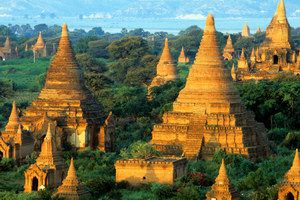MT Sobek
Once a pivotal point on the ancient Silk Road, this “Land of Blue Skies” retains elements of nomadic life and culture. Horses remain at the heart of Mongol culture, shamanic traditions endure, and ancient Buddhist monasteries reflect venerable spiritual traditions. On this fabulous adventure, travel this immense, silent land from the arid semi-desert Khogna Khan Natural Reserve and the Neolithic Ongot monuments near Hustai National Park through seemingly endless rolling steppe to the ochre-colored sands of the Gobi Desert in the south—including the “singing dunes” of Khongoryn Els.
Highlights:- Experience Mongol culture as you meet nomads, witness a Naadam festival, and overnight in traditional gers
- Ride a camel through Gobi's dunes, and walk daily through desert, taiga, and steppe environments
- Explore Khogno Khan Natural Reserve and UNESCO-listed Orkhon Valley, and see incredible Ongot monuments
Important Trip Details:On this trip, you will be hiking two to five hours a day (on most days) and 5-15 miles, up and down mountain trails. Elevations do not exceed 6,000 feet. You need to be in good health and physical condition for this trip.
Minimum Age: 10
Featured Destinations
Ulaan Baatar
Ulaan Baatar
Ulaanbaatar, the capital of the Republic of Mongolia, is situated at the foot of the Bogdo Khan Uul, which rises 3,000 feet above the city. Ulaanbaatar is the political, cultural, economic and transportation center of the country. It has an international airport, the only university in the country and a library with ancient Mongolian, Chinese and Tibetan manuscripts. Founded in 1649 as a monastery town, Ulaanbaatar still preserves the monastery section and residence of the Living Buddha, once Mongolia’s spiritual leader.
|
Destination Guide
|
Gobi Desert
Gobi Desert
The Gobi Desert is a vast zone of desert and desert steppe covering almost 30 percent of the Mongolian territory. The area is often imagined as a lifeless desert like in many other parts of the world. In reality, most part of the Gobi Desert is a land of steppes and it is the home for camel breeders rich with wildlife and vegetation. Wild asses, camels, snow leopards, mountain sheep and gazelles flourish here, as do different types of flora. Dinosaur skeletons and their petrified eggs have been preserved here to the present day. Mongolians consider that there are 33 different Gobi, where sandy desert occupies only 3 percent of the total territory. Climate is extreme in this region. The Great Gobi Reservation established in 1975 was designated by the United Nations as the fourth largest Biosphere Reserve in the world in 1991.
|
Destination Guide
|
|
Bayanzag
|
|
Karakorum
Karakorum
Mongolia's ancient capital, Karakorum (or Kharkhorin), Chinggis Khaan's fabled city, was founded in 1220 in the Orkhon valley, at the crossroads of the Silk Road. It was from there that the Mongol Empire governed, until Khubilai Khaan moved it to Beijing. The symbolic ruins of Karakorum (Harhorin), monumental walls (400 m of length) with 108 stupas, surround the first Buddhist monastery in Mongolia Erdene Zuu Monastery, built in 1586. In 1792, it housed 62 temples and 10,000 lamas; since 1990, it has become an active monastery again. Turtles carved from the stone marked the boundaries of the complex. Kharakhorum is a world famous place for its wonderful relics of the past. In order to get acquainted with Khujurt one has to visit the ruins of the ancient town Karakorum, wel-known throughout the world, where in the 13-th and 24-th centuries the capital of Mongolia was situated. At the time it was a busy, splendid, big city with high culture. Those who would like to visit Karakorum can also see the former Buddhist monastery at Erdene-Zuu erected in the 16-th century. Quite a surprise for the scientists was the discovery of a burial of a Mongolian woman which dates to approximately the 14-th century where also two Egyptian masks, a wooden comb and a bronze mirror in a silk case were found. The ruins of this ancient capital of Mongolia and the Erdene Zuu monastery with their 108 stupas are undoubtedly a great interest to travelers.
|
Destination Guide
|
Khustain Nuruu National Park
Khustain Nuruu National Park
Also known as the Hustai National Park, the Khustain Nuruu National Park is located in Mongolia and is home to the unique Przewalskii horses, steppe gazelles, and 44 other species of mammals as well as many birds, plants, and fish in the Tuul River which runs through the park.
|
|
|
Tsetsee Gun
|
|
View Full Itinerary
Valid Date Ranges
-
July 2025
| 07/01/2025 |
07/14/2025 |
$6,795 per person
|
| 07/24/2025 |
08/06/2025 |
$6,795 per person
|






